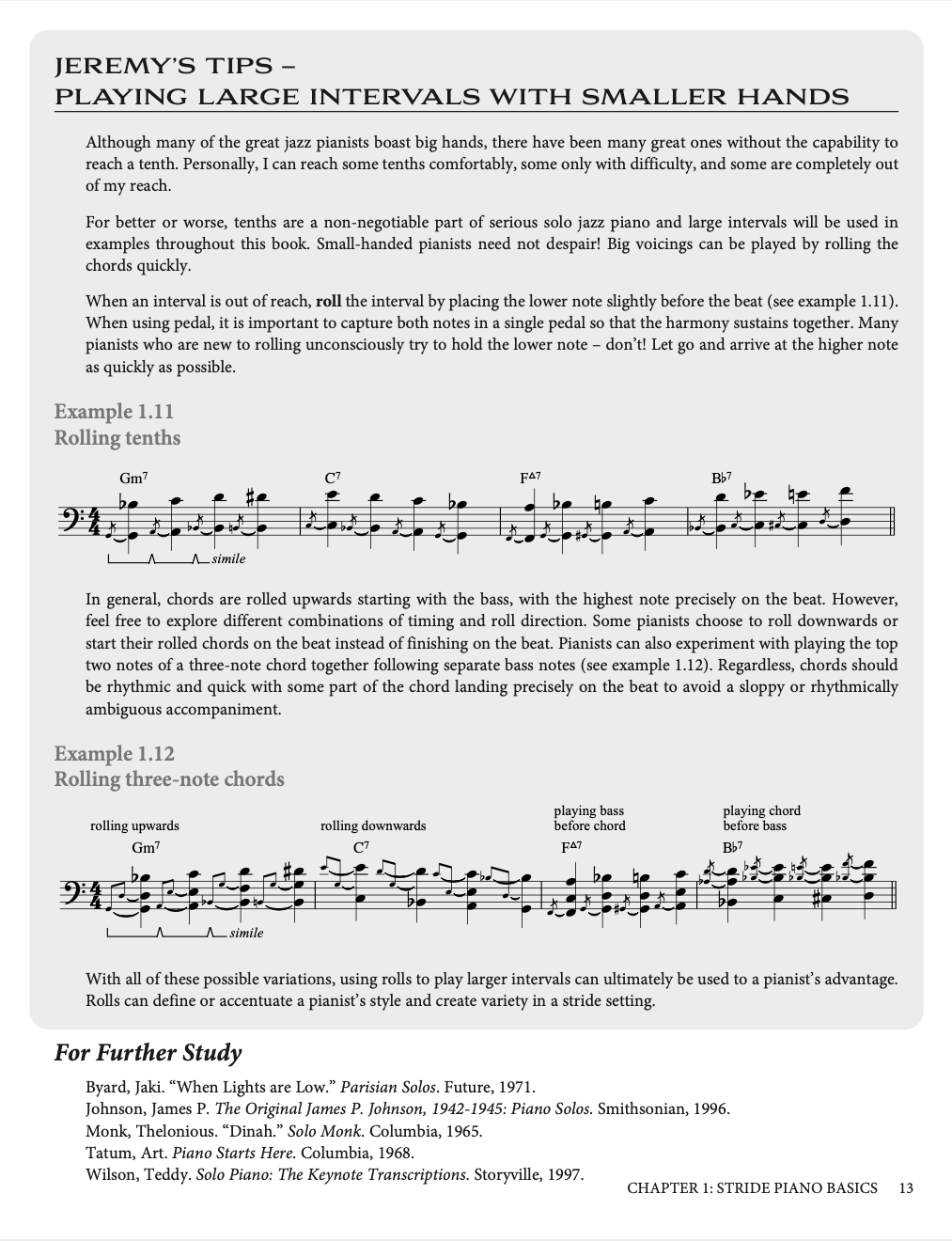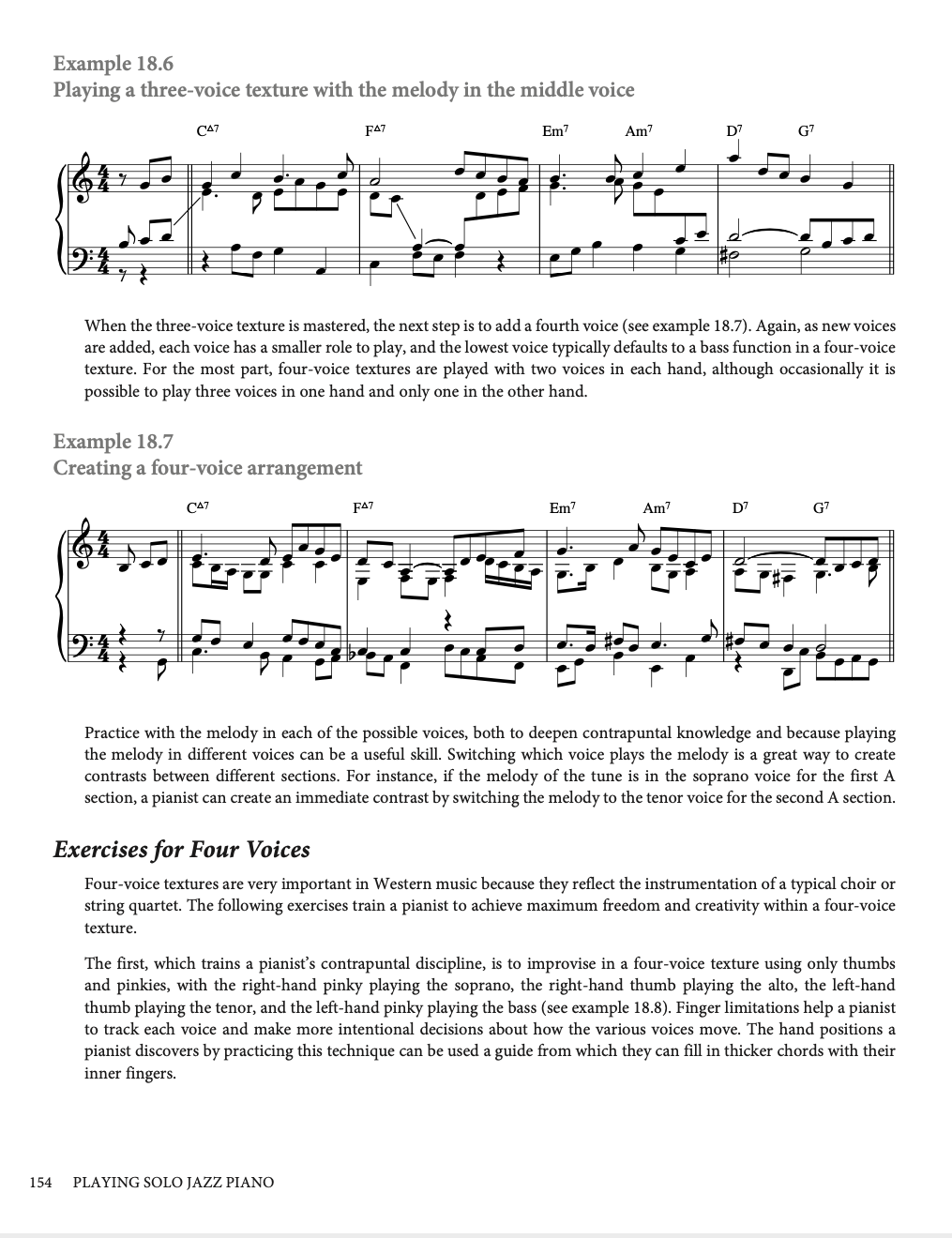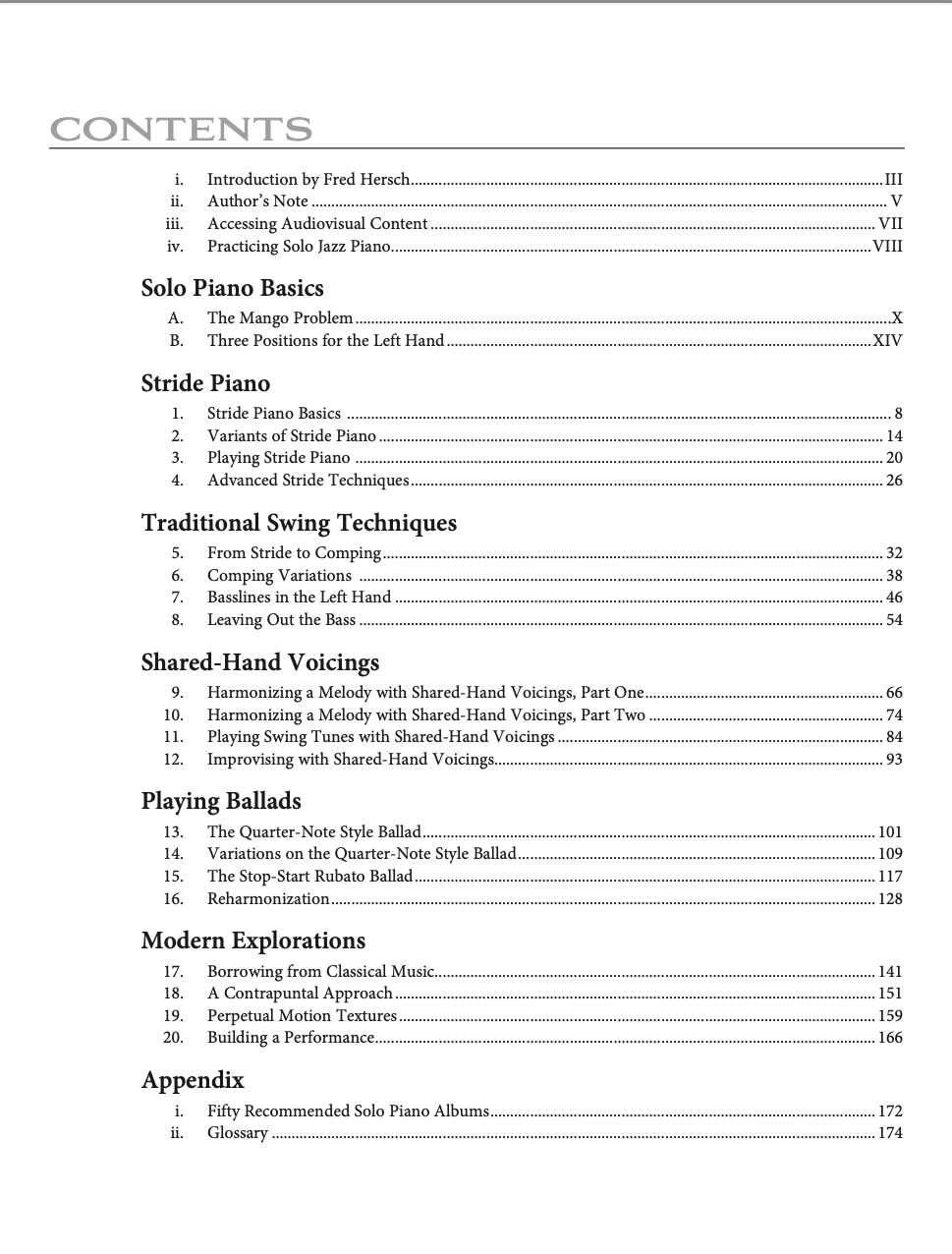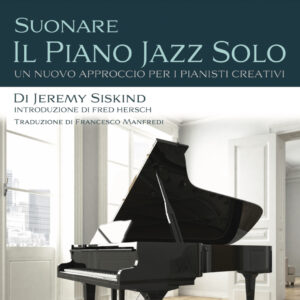Description
“Playing Solo Jazz Piano” is an essential new book for creative jazz pianists. Readers will learn essential solo jazz piano concepts like stride piano, one-handed shell voicings, comping, using basslines, shared-hand voicings, leaving out the bass, and playing ballads. Plus, the book explores modern approaches to solo jazz piano including perpetual motion, counterpoint, and borrowing from classical music. With over 200 musical examples, references to over 100 jazz pianists, and numerous hands-on exercises, “Playing Solo Jazz Piano” is a how-to for passionate, innovative pianists.
The 2nd edition includes two new chapters about solo piano basics plus audiovisual content for each of the book’s roughly 200 examples. Watch as Jeremy plays the example and then applies the concept for each example to “Autumn Leaves.”
“Jeremy has done a remarkable job of organizing the whole history of jazz piano in the book you now hold. It is concise and yet open-ended simultaneously. All of the important concepts and historical styles are here, and presented in a way that is thorough and that will also stimulate you to investigate, listen, experiment and have fun with the world of solo jazz piano.”
– Fred Hersch, pianist, leader Fred Hersch trio, fifteen-time Grammy nominee
“Jeremy Siskind is a gifted pianist, a thoughtful musicians and knowledgeable educator. Written in a clear, organized and concise style, his book Playing Jazz Piano, is an invaluable resource. I highly recommend it for any serious jazz pianist today.”
– Edward Simon, pianist/composer, SFJazz
“Jeremy Siskind’s book takes solo pianists on a journey from basic concepts to a real musical conversation: between both hands, across jazz tradition, with textures and rhythms, counterpoint and new harmonies. There’s a wealth of musical ideas here: how to efficiently practice, creatively delve into a song, and musically tell a story.”
– Tamir Hendelman, pianist (Jeff Hamilton Trio, UCLA lecturer, recording artist)
“I’ve been waiting for this book! Jeremy Siskind presents a cogent and stimulating series of techniques and approaches to creative solo piano playing, rooted in the tradition while inviting both students and professionals to find their own voice and musical personality. The material is historically informed, well-organized, and specific, yet quite open-ended and fun to read and practice. Early and often, the book provides excellent guidance on how to develop the oft-neglected left hand. Finally, the lists of recommended recorded examples from the music’s solo piano masters are an invaluable asset.”
– Jason Yeager, pianist, Assistant Professor of Piano, Berklee College of Music
“Playing Solo Jazz Piano is an extraordinarily comprehensive text on a complex subject. Jeremy expertly covers a breadth of techniques and styles while introducing fresh concepts drawn from his own unique artistic experience. This book is an invaluable resource for the beginner and advanced student alike.”
– David Meder, pianist, Assistant Professor of Piano, University of North Texas











Rob Pallot –
The jazz piano learning journey never ends. Previously I have read other books on jazz piano, and started to think those books are fully comprehensive and I just need to practice thst content; however, having first loved Jeremy’s YouTube videos I purchased this book (1st edition). This book has highlighted lots of gaps in my playing that I was unaware of, and my playing has already begun to improve (while also bring inspired). Well laid out, clear and relevant, I and enjoying learning new things, and old ideas from a different perspective. The chapters on rhythmic ‘comping and voice leading have been particularly useful.
Michael –
This is truly a great jazz teaching book. I also have Jazz Fundamentals Book 1 (it is recommended as the first book to use when learning jazz) but Playing Solo Jazz Piano is the best for how I want to learn jazz (the style of jazz I am interested in).
Thank you Jeremy for the enormous contribution to growing of the jazz piano student community.
Marcus Harbaugh (verified owner) –
I consider myself a bit of a collector of jazz piano method books, and I must have a couple dozen of them by now!
This book easily ranks in the highest tier among them. It’s very focused on its goal, which is to help a pianist develop an array of techniques useful for solo piano playing.
But within that focus, I noticed quite a few descriptions of techniques that I’ve heard players use on recordings, but that I’d never actually seen explained in other books.
There is a lot of very fine pedagogy here, and I look forward to working through the book more thoroughly so as to get some of these techniques into my own playing.
Luís Antônio Machado de Siqueira (verified owner) –
I had not yet seen any book or piano course explaining in such detail the techniques that were developed by the great jazz pianists. Of course, it is possible to find this information, but the student, musician or teacher, will have to be willing to spend a lot of time and money to do so.
I saw your work on YouTube, I quickly realized that it stands out among many others that are there. So I had the curiosity to go out looking for who he was.
That’s how I discovered this wonderful book, a masterpiece that will quickly spread around the world teaching thousands of musicians who don’t have the opportunity to go to the USA to learn Jazz..
Congratulations Jeremy, your talents as a musician and teacher are many and you are certainly sharing this with all of us.
GOD BLESS YOU for that.
Michael Furmaniak –
I have been very much interested in jazz since the late 80s (of last century). One of my first albums was The Köln Concert by Keith Jarrett.
I started to think about learning to play jazz approximately a year ago. I got some books (among them Mark Levine’s The Jazz Piano Book and ABRSM Jazz Piano) and finally saw Jeremy’s mini course on Tonebase. It was much better than anything I saw before and I immediately bought Jazz Piano Fundamentals Book 1 (it is the best starting point for anyone learning to play jazz).
I very much like jazz ballads (my favourite album is Keith Jarrett’s “Melody at Night, with You”) and I will only play jazz solo so I bought Solo Playing Jazz Piano. This book is absolutely great and is a must for anyone interested in playing jazz. I purchase the second addition of this book immediately after it became available. It is, without any doubt, a fundamental book for my learning. It will take me quite a bit of time to fully understand what Jeremy is teaching but I will strive to learn from it. Jeremy is a great teacher! I constantly reference his YouTube videos (I love his most recent performance of Misty).
I would so much like to be able to learn jazz from (I hope) his future course with Video Exchange option.
Thank you for your piano jazz teaching, Jeremy!
Michael
Justin Highland (verified owner) –
This book is absolutely fantastic. There are so many awesome techniques to explore, and even better there are video examples of everything, which makes it all even more inspiring, motivating and extremely useful!
Even as an experienced player, there were a lot of techniques I hadn’t even considered or knew about, or had heard but never saw them categorized and broken down like this. Please note, the book is definitely not for beginners. Having a strong sense of note reading and rhythmic dictation/understanding is recommended.
The section on Ballads is worth the price alone! Jeremy is a world class player and teacher, a much needed revivalist and innovator in Jazz Education, which has been done so poorly for so long. I wish so badly this book and Jazz Piano Fundamentals were around when I started playing Jazz over 15 years ago.
I would give this book 10/5 stars if I could.
Eli –
“Jazz Piano Fundamentals” is a great book for teachers like me who want to bring the joy of jazz piano into their classrooms. The book breaks down the basics of jazz piano in a way that’s easy to understand, even if you’re not a music expert.
What I love about this book is how practical it is. It doesn’t just throw theory at you; it gives you hands-on exercises and examples you can use in your lessons. As a teacher, I appreciate the ready-made lesson plans and adaptable teaching tips that make it easy to share the excitement of jazz piano with my students.
The book covers a bit of everything, from simple chords to cool improvisation techniques. It’s not just about learning the notes; it’s about making music come alive.
“Jazz Piano Fundamentals” is like a one-stop-shop for jazz styles and history. It helps me expose my students to the rich world of jazz piano, no matter their level. Thanks to this book, teaching jazz piano has become more fun and engaging for me and my students. It’s a simple, practical, and inclusive guide that has truly made a positive impact on my role as an educator.
Eli –
As a music teacher, I stumbled upon a gem of a book that has completely transformed the way I approach solo jazz piano. Solo Jazz Piano Guide is a straightforward yet comprehensive resource that has proven to be a game-changer for both me and my students.
What makes this book stand out is its perfect blend of theory and hands-on practice. It breaks down the history of solo jazz piano in an easy-to-understand way, making it accessible for musicians at any level. The practical exercises provided have become a staple in my teaching approach, helping me explain complex concepts in a way that resonates with my students.
One standout feature is the focus on creativity. The book encourages a fearless exploration of personal style and expression through improvisation techniques. This not only enhances my own playing but also allows me to inspire my students to find their own unique voice in the world of jazz.
I can now share these examples with my students, making the learning experience more engaging and relevant. It’s like bringing the history of solo jazz piano right into our practice sessions.
In a nutshell, “Solo Jazz Piano Guide” has become my go-to resource for jazz instruction. It’s user-friendly, engaging, and has added a new layer of excitement to my teaching. If you’re an educator looking to spice up your lessons on solo jazz piano approach, this book is a must-have in your toolkit.
Enzo Monaco –
I always wanted to learn how to play like Bill Evans on his album “Alone”, but I never understood how he managed to have that absurd creativity that jazz and the piano provide.
This book answers my questions. Although it’s not a book for beginners (which I am), it’s on my must-read list.
Thanks Jeremy for the great job you’ve been doing!